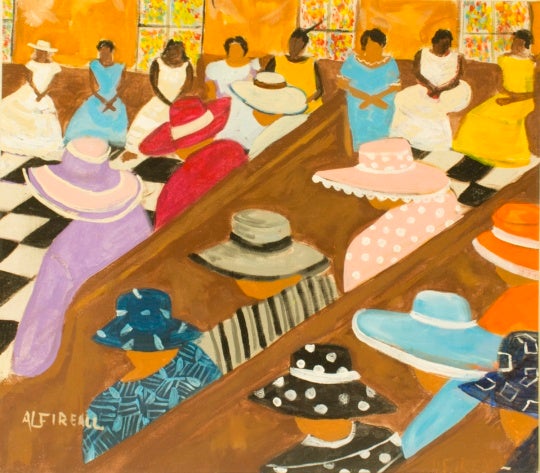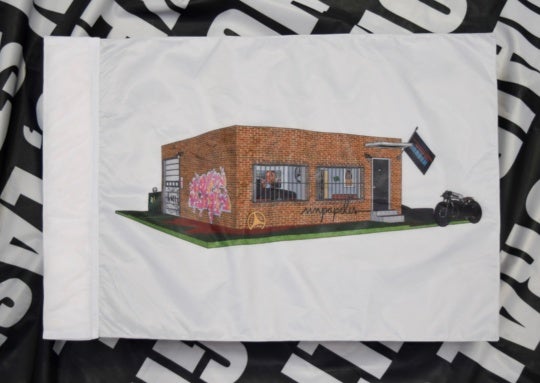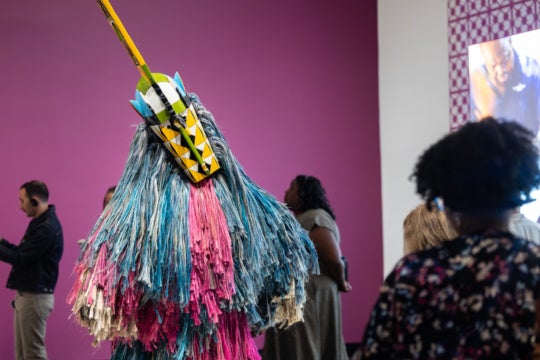
Though the rest of us have a couple months left before we can call this year over, Chelsea Raflo and the other two participants in MINT Gallery’s Leap Year artist mentorship program have celebrated early. Consisting of a full year of lectures, exhibitions, and fundraisers, the program culminated with a final exhibit at The Department Store that opened October 12. The endeavor left Raflo surprisingly energized for her next projects—a quality she’ll need in order to keep working at the pace that Leap Year expected.
She builds her works with an intense curiosity, and a slight masochism, regarding process. Her stop-motion videos layer writing, painting, drawing, and experimental audio into narratives that unfold like oddly elegant, animated children’s books. She takes a multimedia approach to nearly all of her works, with film often serving as the canvas on which she captures her various stylizations. Though collage tends to emphasize the technical skill required to handle multiple mediums, film allows Raflo to do her tedious work behind the scenes. Because of this, her movies have a sense of weightless motion that effortlessly reveal the story at the center of the work.

I sat down with Raflo at Hodgepodge Coffeehouse and Gallery after a short delay—she couldn’t find her car keys as they were sneakily hiding in a pile of jewelry. Things went smoothly after that, though, as we settled in with our coffees and began to chat about art. She was quite open about the heartbreaks of animation, and she laughed easily at the mention of a scene in Parks and Recreation where a depressed character spends two solid weeks creating a twenty-second stop motion movie. But it’s worth it for Raflo to labor so intensely, to the benefit of her viewers, and her experimental drive will keep her work fresh throughout her career.
Grace Thornton: I noticed—and this seems like it’s a kind of a trend—that you concentrated in creative writing along with your studio degree. Do you have any insight into why that’s popular right now with a lot of artists? And for you personally, why is that something you were interested in doing?
Chelsea Raflo: I’ve been thinking about that a lot lately. Writing was my first interest, I guess. I always did drawing and writing at the same time, but when I went to college I planned to just do creative writing and literature, and then ended up getting more focused on art while I was there. I’ve been coming back to it a lot; I feel like it’s at the core of so much good artwork that I’ve seen. Anything I’ve done myself that I’ve liked—I think has been driven by writing at first. Even just words, not necessarily writing stories, just … verbal.
A lot of it is how much more we’re writing when we communicate with other people, with social media and stuff like that. Even things as seemingly simple as abbreviations—how it’s your particular dialect, the way that you write to other people.
GT: It almost becomes symbols. It literally does with “at” symbols and things like that, but even abbreviation reduces a word to the point that it’s hardly a word anymore. I guess there’s something artistic, inherently, in that.
CR: Like Twitter, for example, people are forced to write shorter statements. So every word choice or symbol becomes so much more important. That’s not really part of my work, but as far as verbal things having a lot of power and paying attention to that, definitely.
GT: Right. It’s kind of become a cultural touchstone, even if an artist’s work doesn’t say “This is about Twitter,” you can kind of embrace a generation through short phrasing.


CR: I read a lot of Alice Munro short stories this year. She talks about how she writes herself into a scene—like she’ll make it come to life, but not necessarily through plot vehicles—and then just feels it out. I think that’s a good metaphor for almost any media.
GT: Can you elaborate on that a little bit?
CR: With painting, I’ll focus in on a detail. You have an idea of what you want to paint when you start, but then one thing becomes a focus, and it spreads out from there. You sort of write yourself into a painting and then it fills out.
GT: Are videos something you want to continue to concentrate on?
CR: I just finished what I showed at the final [Leap Year] exhibition. I made a music video. I was interested in that format—why can’t it be fine art? I always felt there was a stigma about aspiring to make music videos. I just wanted to play with it.
When I get really into a project, it always makes me excited to do something else [laughs]. I think with the next thing I’ll do, I want to combine everything into digital paintings. I want to make really short videos or GIF files hooked up to a monitor or on a portable DVD player, built into a structure so that it’s freestanding. So instead of making a video to show at multiple places, this video would only exist in the structure. And incorporate painting and sculpture into the actual physical part of it.
GT: So it’s a new way of doing multimedia?
CR: I’m sure there are people who have done it, in some regard. It makes things easier for me, in my head, to think that I’m doing a painting series and still make filmic content.

GT: Tell me about the audio portion of your videos. Do you do instruments, singing? How do you put that together?
CR: The last one I wrote as a song—I was just experimenting. I’m really not a good musician [laughs]. So I took it to my friend who’s awesome at producing, basically. We recorded it and layered it a bunch of times.
GT: What is the actual sound, though?
CR: Oh, synthesizers and guitars and vocals. A lot of vocal layering to make it sound kind of creepy.
GT: On [the film] Sighting I thought it might be vocals, it’s hard to tell. It sounds like something that would be at the beginning of a Lykke Lie song, that breathy “is that a human voice?” kind of thing.
CR: I like that. I like hearing spoken vocals over interesting music. It gives it more of a found-sound aspect.
GT: Do you want to briefly tell us about the Leap Year program that you did?
CR: It feels like art immersion. I guess when I started I didn’t realize how focused it would be on making community partnerships. It’s not just like, “here’s a studio, get to work” and you produce something amazing for the next year. It gets you familiarized with what’s happening in Atlanta. Which is awesome, because that’s not the kind of thing that I naturally take the initiative to do. I tend to not pay as close of attention as I should. It was a really big honor, to have a program to support you just because you applied.
I was worried—I thought I was going to end the program and just be floating around, lost, without someone telling me what the next thing is. But I don’t feel that way at all now.




